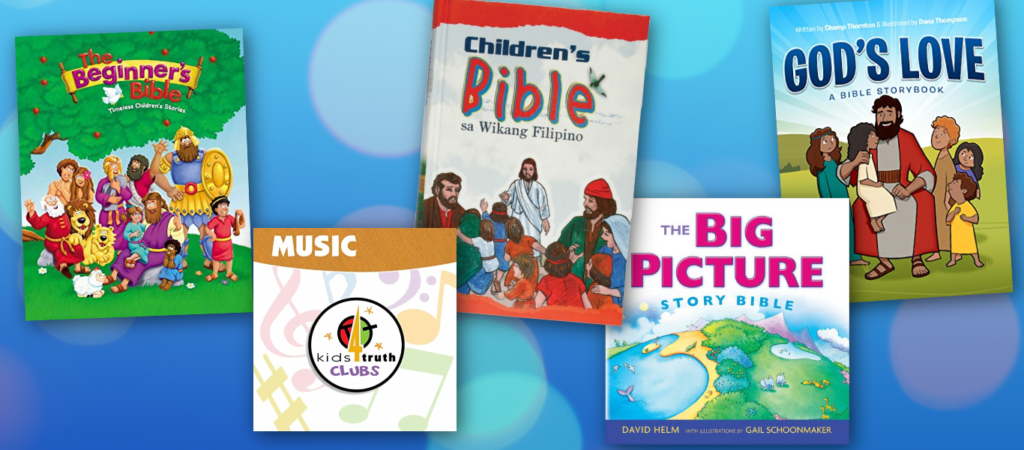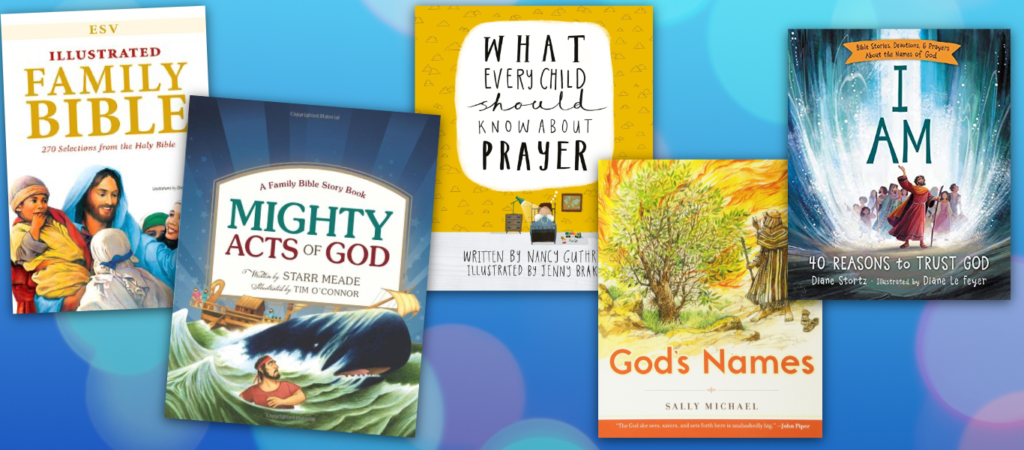Given our stage of life (four children under 10), we are regularly asked what children’s Bibles or resources are most useful. Sarah Arnold wrote the criteria we use to decide what stays on our bookshelves and regularly in use:
I stick to books that follow the essential line of Scripture.
Wording differently from Scripture is not the same as saying more than Scripture says. Stories that sound like they are being told in a simpler way by a parent or grandparent can be wonderful; stories that add details for interest, personalizing the story and trying to make it “relevant”… I choose to stay away. It is too easy to lose the essence of the story in the weeds of the additions. Often, the culture of the place or time of the author further complicates the situation or distorts the story.
I choose books that show respect for the inherent intelligence of children.
Some books ask questions after the story like “How many camels are in the picture?”. Other books ask questions like “Why was Proverbs written?”. (Both from actual books.) The first question is not the least bit interesting; more significantly it’s completely unrelated to the biblical text. The second is a timeless question, answered clearly in a way that children can understand but adults could also benefit. In essence, if I have no patience for and benefit from the book, I don’t expect my children to.
I prefer books that are conservative and careful in their illustrations.
I do not feel that they all must have the flannelgraph character look. I love varied, careful, beautiful artwork. This area is not as critical as the others as it is more transparent, more easy to point out and overlook. We have a story Bible with some blonde Jews in it. This is not a deal-breaker for me, but I also do not want to skew the details of biblical history. Our family is not Jewish; we are some who have been blessed through the mystery of the gospel that angels long wanted to know. What good is accomplished in oversimplifying (hence distorting) what even angels did not understand anyway? Again, though, if the text is careful, I will use the book after drawing attention to artistic liberties. Kids are smart. They do not need you to wax eloquent. With a simple comment they can understand, move on, and benefit.
I love to have a variety of story Bibles.
This value I learned with our eldest when he started quoting his story Bible as though it were the ultimate authority. Since that was the only Bible he had read several times, it became the Bible for him. In this case, it could have been worse—this particular edition was careful in its telling, and the main problem was his assumption that if it wasn’t in his story Bible, it wasn’t true. But in the process, I recognized my need to provide more than just one telling. Of course, we also regularly remind the kids of the difference between a story Bible and the actual Bible. But the point stands that the beautiful, complex story of Scripture can be–must be! –heard and explained and understood many times and with a richness of faithful emphases.
I like to have some books that function like well-written children’s commentaries.
These books carefully explain Bible stories and go beyond that to trace themes through the whole of Scripture. They articulate the questions that Scripture should leave in your mind and show you biblical answers to these questions. Essentially, I am looking for books that trace the unfolding, progressive story of Scripture. I want my children to begin their experience of Scripture with a solid understanding of the overarching story, the major characters in it, and who the Hero of the entire book is. These can be outstanding tools to have in preparing your children for a solid understanding of biblical text when they begin reading Scripture itself.
Ultimately, Bible storybooks are only preparations for the real thing.
Of course, the ultimate goal is for kids to read the Bible itself. Nothing can compare with God’s Word. Nothing else is necessary. Moving gradually to the full Bible is not an inconsiderable transition due to its massive size, complex stories, and even troubling passages. Critical to success is having a parent or two to support the journey. What that looks like in our home is having an established time of day when we each read the Bible, separately but together; this removes the pressure of a decision from the children, while also showing them that Bible reading is in no way just “a kid thing”. It also means talking about what we are reading, asking questions and sharing. Paying attention to where your child is reading is also helpful, so you can be alert to concerns or questions they may have, even if they would not be comfortable to ask them.
But what about the objectionable stuff?
A common question is about the troubling content—for instance, Song of Solomon or Tamar or the prostitute cut in twelve pieces (Judges 20–21). We view this not as a liability but an asset of having our children read Scripture. Kids will learn about sex somehow and some time. We have been ready and available to answer the questions our kids may have, in an open and simple way. Often, our children in their naïveté have glossed over some of the most troubling passages. They found the talk about someone’s belly button (Song 7:2) totally hilarious. In other cases, their questions from Scripture lead to the conversations we need to have with them and that are appropriate to their age. While conversations about sex with children are not leisure-time activity for anyone, they are critical. The Bible is an outstanding place to start.
The parent who is deeply committed to personal Bible reading will understand that these cautions and concerns, or the details of how to put the idea into daily practice, are not at all the main thing. A much bigger question is whether you are already personally convinced that your child should read the Bible. If not, you need to start there. Read it yourself. There is no other book like it.
Some Recommended Books
So that’s a lot of ideas. But where to start? What to buy? Here are some books we give as gifts and regularly use. The images are directly followed by links where you can find them.

- The Beginner’s Bible
- Kids4Truth – Theologically Rich Hymns for Children
- The Big Picture Story Bible
- Children’s Bible sa Wikang Filipino
- God’s Love: A Bible Storybook


0 Comments